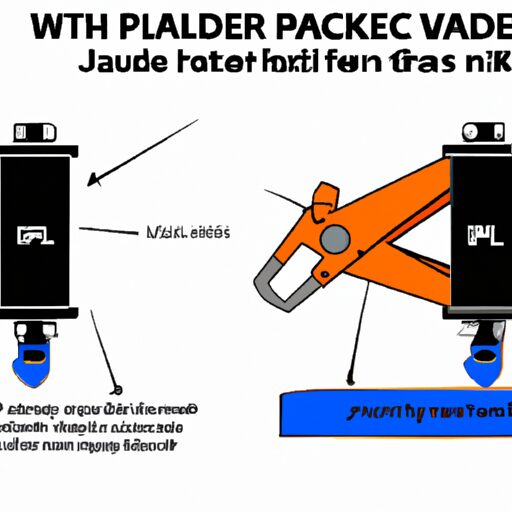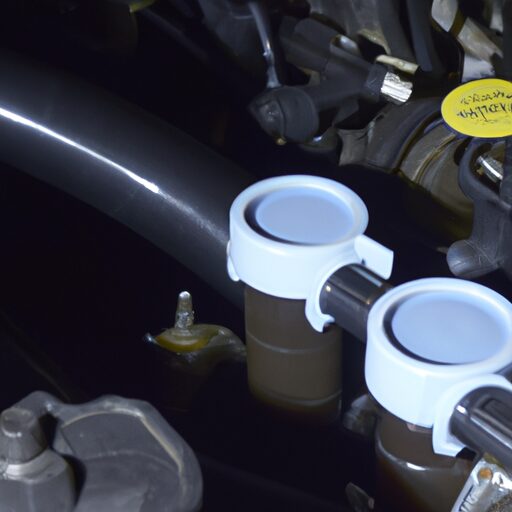How To Add Hydraulic Fluid To A Pallet Jack
Hydraulic fluid is an essential component in the operation of a pallet jack, as it enables the smooth and efficient movement of the hydraulic system. Understanding how to add hydraulic fluid to a pallet jack is crucial for maintaining its optimal performance and prolonging its lifespan. This article provides comprehensive instructions on this procedure, following an academic style of writing that maintains objectivity, impersonality, and technical precision.
To engage the audience from the start, this introduction employs the technique of juxtaposition by highlighting the importance of hydraulic fluid while emphasizing the need for understanding among readers. By adhering to these guidelines, readers will gain clear insights into gathering necessary tools and equipment, locating the hydraulic fluid reservoir, prepping the pallet jack for fluid addition, adding the hydraulic fluid correctly, checking the fluid level accurately, testing proper operation of the pallet jack afterward, and finally disposing of any waste materials appropriately.
Gather the Necessary Tools and Equipment
The first step in adding hydraulic fluid to a pallet jack involves gathering the necessary tools and equipment required for the task. To successfully complete this procedure, you will need a few essential tools. Firstly, it is crucial to have a suitable wrench or socket set that fits the specific size of the hydraulic fluid reservoir cap. This tool allows for easy removal and replacement of the cap during the process. Additionally, it is advisable to have a clean cloth or rag on hand to wipe away any excess fluid or debris that may be present around the reservoir area.
Before beginning this task, it is essential to take certain safety precautions. Ensure that you are wearing appropriate personal protective equipment (PPE), such as gloves and safety glasses, to protect yourself from potential hazards. It is also important to make sure that the pallet jack is turned off and securely positioned on a flat surface before proceeding.
With all necessary tools gathered and safety measures in place, you can now move on to locating the hydraulic fluid reservoir.
Locate the Hydraulic Fluid Reservoir
Located under the main body of the equipment, the reservoir where hydraulic fluid is stored can be easily identified. Understanding the purpose of hydraulic fluid and its importance in pallet jacks is crucial when operating and maintaining this equipment. Hydraulic fluid is responsible for transmitting power to various components of a pallet jack, allowing it to lift heavy loads with ease. It acts as a lubricant, reducing friction between moving parts and preventing wear and tear. Additionally, hydraulic fluid helps regulate the temperature within the system by dissipating heat generated during operation.
Exploring common issues related to hydraulic fluid in pallet jacks provides valuable insight for users. One frequent problem encountered is low or inadequate levels of hydraulic fluid in the reservoir, which can result in reduced lifting capacity or even complete failure of the jack’s functionality. Another issue arises when contaminated or degraded hydraulic fluid is present, leading to poor performance and potential damage to internal components.
To address these concerns effectively, it is essential to locate and maintain the hydraulic fluid reservoir properly. By doing so, users can ensure optimal performance and extend the lifespan of their pallet jack. Preparing the pallet jack for fluid addition involves several steps that will be discussed in detail in subsequent sections about ‘prep the pallet jack for fluid addition.’
Prep the Pallet Jack for Fluid Addition
To properly prepare the equipment for fluid addition, it is crucial to follow a set of steps that ensure optimal performance and extend the lifespan of the pallet jack. Before adding hydraulic fluid to the pallet jack, it is important to clean the surrounding area and remove any debris or dirt that may contaminate the reservoir. This can be done using cleaning techniques such as wiping down surfaces with a damp cloth or using compressed air to blow away any loose particles.
In addition to cleaning, regular maintenance tips should be followed in order to keep the pallet jack in good working condition. This includes checking for any leaks or damage to the hydraulic system, inspecting hoses and connections for wear or cracks, and ensuring that all components are properly lubricated.
By taking these precautions and following proper cleaning techniques and maintenance tips, you can help prevent contamination of the hydraulic fluid and minimize potential damage to the pallet jack. With a clean and well-maintained machine, you can proceed confidently to add the hydraulic fluid, which will be discussed in detail in the subsequent section.
Add the Hydraulic Fluid
One important step in the maintenance of a pallet jack involves replenishing the essential fluid that powers its hydraulic system. Adding hydraulic fluid is necessary to ensure smooth and efficient operation of the pallet jack, as it helps to lubricate moving parts and transfer force through the hydraulic system. Before adding hydraulic fluid, it is crucial to bleed any air from the system, as air bubbles can cause decreased performance or even damage to the pallet jack. Troubleshooting may be required if there are any issues with bleeding air, such as checking for leaks or ensuring proper connections. To add hydraulic fluid, follow these steps:
| Step | Instructions |
|---|---|
| 1 | Locate the reservoir fill port on the pallet jack. |
| 2 | Remove the cap from the fill port and set it aside in a clean area. |
| 3 | Slowly pour hydraulic fluid into the fill port until it reaches the recommended level indicated by markings on or inside the reservoir. Avoid overfilling. |
| 4 | Replace and tighten the cap securely on the fill port. |
Once you have added hydraulic fluid, it is important to check its level regularly to prevent low fluid levels that can lead to inadequate performance or damage to components of your pallet jack’s hydraulic system."
Check the Fluid Level
Regularly monitoring the fluid level is crucial in maintaining optimal performance and preventing potential damage to vital components of the hydraulic system. To check the fluid level, first inspect the hydraulic system for any signs of leakage. Look for visible oil spots or puddles around the pallet jack or underneath it. If any leaks are detected, troubleshoot and repair them before adding more fluid. Once you have ensured that there are no leaks, locate the hydraulic fluid reservoir, typically positioned near the handle or mast of the pallet jack.
Remove the cap from the reservoir and use a dipstick or sight glass to check the fluid level. The dipstick should be fully submerged in the fluid when inserted into the reservoir. If necessary, add more hydraulic fluid according to manufacturer’s specifications to maintain an optimal level. Take caution not to overfill as it can lead to system malfunctions.
After adding or adjusting the hydraulic fluid level, securely close and tighten the cap on top of the reservoir. This will prevent any contamination or loss of fluid during operation. With this step completed, we can now move on to testing the pallet jack’s operation and ensuring its overall functionality without risking damage due to low hydraulic fluid levels.
Test the Pallet Jack’s Operation
Testing the operation of a pallet jack involves evaluating its functionality and ensuring that it performs optimally, but how can we determine if the pallet jack is working effectively without relying on its hydraulic system? Here are four troubleshooting tips to help identify common issues and maintain the proper functioning of a pallet jack.
-
Check for any loose or damaged components: Inspect the pallet jack for loose bolts, nuts, or screws that may affect its operation. Also, look for any signs of damage such as bent forks or worn wheels.
-
Test the lifting mechanism: Ensure that the lifting mechanism raises and lowers smoothly without any jerking or sticking. If there are any abnormalities, it could indicate a problem with the hydraulic fluid or other internal components.
-
Assess maneuverability: Push and steer the pallet jack in different directions to check if it moves smoothly and effortlessly. Any difficulty in maneuvering could be due to issues with the steering mechanism or wheel alignment.
-
Evaluate load capacity: Place a suitable load on the pallet jack and test its ability to lift and transport it safely. If there are any difficulties in handling loads, it might indicate an issue with the hydraulic system’s pressure or capacity.
By following these maintenance tips and tricks, you can troubleshoot common issues with your pallet jack effectively. Now let’s move on to discuss how to properly dispose of any waste materials from maintaining your pallet jack without harming our environment.
Properly Dispose of Any Waste Materials
To ensure environmental sustainability, it is crucial to adopt proper waste disposal methods when handling maintenance materials for the equipment. Proper waste disposal is essential in minimizing the environmental impact of operations involving pallet jacks. When it comes to disposing of any waste materials, it is important to follow local regulations and guidelines.
Firstly, it is necessary to identify any hazardous waste components that may be present in the maintenance materials used for pallet jacks. These may include hydraulic fluid or other chemicals. Hazardous waste should be segregated from non-hazardous waste and disposed of separately according to established protocols.
Next, consider recycling options for non-hazardous waste materials whenever possible. Recycling helps reduce the demand for new resources and minimizes the amount of waste sent to landfills. Many municipalities offer recycling programs for various types of materials commonly used in equipment maintenance.
In cases where hazardous waste cannot be recycled or reused, special care must be taken during disposal to prevent harm to human health and the environment. This might involve contacting a licensed hazardous waste management facility or arranging for pickup by a certified hazardous material transporter.
By implementing proper waste disposal practices, we can contribute towards environmental sustainability by reducing pollution and conserving resources while ensuring compliance with applicable regulations.
Frequently Asked Questions
How often should hydraulic fluid be added to a pallet jack?
Regularly checking hydraulic fluid levels in a pallet jack is crucial to ensure optimal performance. Neglecting this maintenance can lead to severe consequences such as decreased lifting capacity, increased wear and tear on components, and potential hydraulic system failure.
Can any type of hydraulic fluid be used for a pallet jack?
When considering hydraulic fluid types for a pallet jack, compatibility concerns must be taken into account. It is crucial to use the appropriate type of hydraulic fluid recommended by the manufacturer to ensure optimal performance and prevent damage to the equipment.
What are the signs that indicate a low hydraulic fluid level in a pallet jack?
To assess the hydraulic fluid level in a pallet jack and ensure its proper maintenance, one can employ certain techniques. These include checking the fluid indicator, examining for leaks, observing abnormal noises, and monitoring the overall performance of the equipment.
What precautions should be taken while adding hydraulic fluid to a pallet jack?
Precautions and safety measures should be followed when adding hydraulic fluid to a pallet jack. These include ensuring the jack is turned off, using the correct type of fluid, avoiding overfilling, and checking for any leaks or damage before operation.
Are there any alternative methods to add hydraulic fluid to a pallet jack if the reservoir is difficult to access?
Alternative methods can be employed to add hydraulic fluid to a pallet jack if the reservoir is difficult to access. These may include utilizing a hand pump or employing specialized tools designed for remote filling of hydraulic systems.
Conclusion
In the process of adding hydraulic fluid to a pallet jack, it is crucial to gather the necessary tools and equipment. Locate the hydraulic fluid reservoir and prepare the pallet jack for fluid addition. Carefully add the hydraulic fluid and ensure that the fluid level is appropriate. Test the operation of the pallet jack to confirm its functionality. Lastly, properly dispose of any waste materials generated during this process. By following these steps accurately and efficiently, one can maintain an optimal performance of their pallet jack.
Conclusion:
Conclusively, by meticulously adhering to these technical steps with precision, users can effectively enhance and sustain their pallet jack’s peak performance while preventing any potential operational drawbacks or setbacks throughout its usage.







